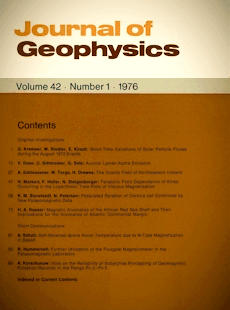Pseudo-single-domain effects and single-domain multidomain transition in natural pyrrhotite deduced from domain structure observations
Article Sidebar
Published:
Apr 8, 1976
Keywords:
Rock magnetism,
Domain structure,
Pyrrhotite,
Diabase,
Palaeomagnetism
Volumes

Vols. 1-18 (1924-1944), ISSN 0044-2801
Main Article Content
H. Soffel
Institute for General and Applied Physics, University of Munich, Garmany
Abstract
The domain configuration of primary pyrrhotite in a Devonian diabase was studied using the Bitter pattern technique. Due to the uniaxial symmetry the multidomain grains have a rather simple domain structure. The single-domain — multidomain transition occurs at an average particle diameter of 1.6 μm. In the multidomain grains clusters of inclusions seem to produce pseudo-single-domain effects with complicated domain configurations. Such pseudo-single-domain effects are necessary for the interpretation of the magnetically hard component of remanence which cannot be explained by the observed abundance of true single-domain particles alone.
 ARK: https://n2t.net/ark:/88439/y061450
ARK: https://n2t.net/ark:/88439/y061450
Permalink: https://geophysicsjournal.com/article/91
Article Details
How to Cite
Soffel, H. (1976). Pseudo-single-domain effects and single-domain multidomain transition in natural pyrrhotite deduced from domain structure observations. Journal of Geophysics, 42(1), 351-359. Retrieved from https://journal.geophysicsjournal.com/JofG/article/view/91
Section
References
Bin, M., Pauthenet, R. (1963) Magnetic anisotropy in pyrrhotite. J. Appl. Phys. 34:1161-1162
Bitter, F. (1931) On inhomogeneities in the magnetization of ferromagnetic materials. Phys. Rev. 38:1903-1905
Chikazumi, S., Suzuki, K. (1955) On the maze domain of silicon-iron crystal. J. Phys. Soc. Japan 10:523-534
Elmore, W.C. (1938) Ferromagnetic colloid for studying magnetic structures. Phys. Rev. 54:309-310
Hanss, R.E. (1964) Thermochemical etching reveals domain structure in magnetite. Science 146:398-399
Kittel, C. (1949) Physical theory of ferromagnetic domains. Rev. Mod. Phys. 21:541-583
Kneller, E. (1962) Ferromagnetismus. Springer Berlin
Neel, L. (1949) Theorie du trainage magnetique des ferromagnetiques en grains fins avec leur applications aux terres cuites. Ann. Geophys. 5:99-136
Soffel, H. (1963) Untersuchungen an einigen ferrimagnetischen Oxyd- und Sulfidmineralien mit der Methode der Bitterschen Streifen. J. Geophys. 29:21-34
Soffel, H. (1966) Stress Dependence of the Domain Structure of Natural Magnetite. J. Geophys. 32:63-77
Soffel, H. (1968) Die Bereichsstrukturen der Titanomagnetite in zwei Basal ten und die Beziehung zu makroskopisch gemessenen magnetischen Eigenschaften dieser Gesteine. Habilitation thesis, Nat. Fak. Univers. Mtinchen
Soffel, H. (1969) The origin of thermoremanent magnetization of two basalts containing homogeneous single phase titanomagnetite. Earth Planet. Sci. Lett. 7:201-208
Soffel, H. (1970) The Influence of the Dislocation Density and Inclusions on the Coercive Force of Multidomain Titanomagnetites of the Composition 0.65 Fe 2 Ti04 -0.35 Fe30 4 in Basalts as Deduced
from Domain Structure Observations. J. Geophys. 36:113-124
Soffel, H. (1971) The single-domain - multidomain transition in natural intermediate titanomagnetites. J. Geophys. 37:451-470
Soffel, H., Petersen, N. (1971) Ionic etching of titanomagnetite grains in basalts. Earth Planet. Sci. Letters ll:312-316
Stacey, F.D. (1962) A generalized theory of thermoremancnce, covering the transition from single-domain to multidomain magnetic grains. Phil. Mag. 7:1887-1899
Stacey, F.D. (1963) The physical theory of rock magnetism. Adv. Phys. 12:45-133
Stacey, F.D., Banerjee, S. K. (1974) The physical principles of rock magnetism. Elsevier Amsterdam, p. 110-114
Syono, Y. (l965) Magnetocrystalline anisotropy and magnetostriction of Fe3 O4 - Fe2 Ti O4-series with special application to rock magnetism. Jap. J. Geophys. 4:71-143
Bitter, F. (1931) On inhomogeneities in the magnetization of ferromagnetic materials. Phys. Rev. 38:1903-1905
Chikazumi, S., Suzuki, K. (1955) On the maze domain of silicon-iron crystal. J. Phys. Soc. Japan 10:523-534
Elmore, W.C. (1938) Ferromagnetic colloid for studying magnetic structures. Phys. Rev. 54:309-310
Hanss, R.E. (1964) Thermochemical etching reveals domain structure in magnetite. Science 146:398-399
Kittel, C. (1949) Physical theory of ferromagnetic domains. Rev. Mod. Phys. 21:541-583
Kneller, E. (1962) Ferromagnetismus. Springer Berlin
Neel, L. (1949) Theorie du trainage magnetique des ferromagnetiques en grains fins avec leur applications aux terres cuites. Ann. Geophys. 5:99-136
Soffel, H. (1963) Untersuchungen an einigen ferrimagnetischen Oxyd- und Sulfidmineralien mit der Methode der Bitterschen Streifen. J. Geophys. 29:21-34
Soffel, H. (1966) Stress Dependence of the Domain Structure of Natural Magnetite. J. Geophys. 32:63-77
Soffel, H. (1968) Die Bereichsstrukturen der Titanomagnetite in zwei Basal ten und die Beziehung zu makroskopisch gemessenen magnetischen Eigenschaften dieser Gesteine. Habilitation thesis, Nat. Fak. Univers. Mtinchen
Soffel, H. (1969) The origin of thermoremanent magnetization of two basalts containing homogeneous single phase titanomagnetite. Earth Planet. Sci. Lett. 7:201-208
Soffel, H. (1970) The Influence of the Dislocation Density and Inclusions on the Coercive Force of Multidomain Titanomagnetites of the Composition 0.65 Fe 2 Ti04 -0.35 Fe30 4 in Basalts as Deduced
from Domain Structure Observations. J. Geophys. 36:113-124
Soffel, H. (1971) The single-domain - multidomain transition in natural intermediate titanomagnetites. J. Geophys. 37:451-470
Soffel, H., Petersen, N. (1971) Ionic etching of titanomagnetite grains in basalts. Earth Planet. Sci. Letters ll:312-316
Stacey, F.D. (1962) A generalized theory of thermoremancnce, covering the transition from single-domain to multidomain magnetic grains. Phil. Mag. 7:1887-1899
Stacey, F.D. (1963) The physical theory of rock magnetism. Adv. Phys. 12:45-133
Stacey, F.D., Banerjee, S. K. (1974) The physical principles of rock magnetism. Elsevier Amsterdam, p. 110-114
Syono, Y. (l965) Magnetocrystalline anisotropy and magnetostriction of Fe3 O4 - Fe2 Ti O4-series with special application to rock magnetism. Jap. J. Geophys. 4:71-143











